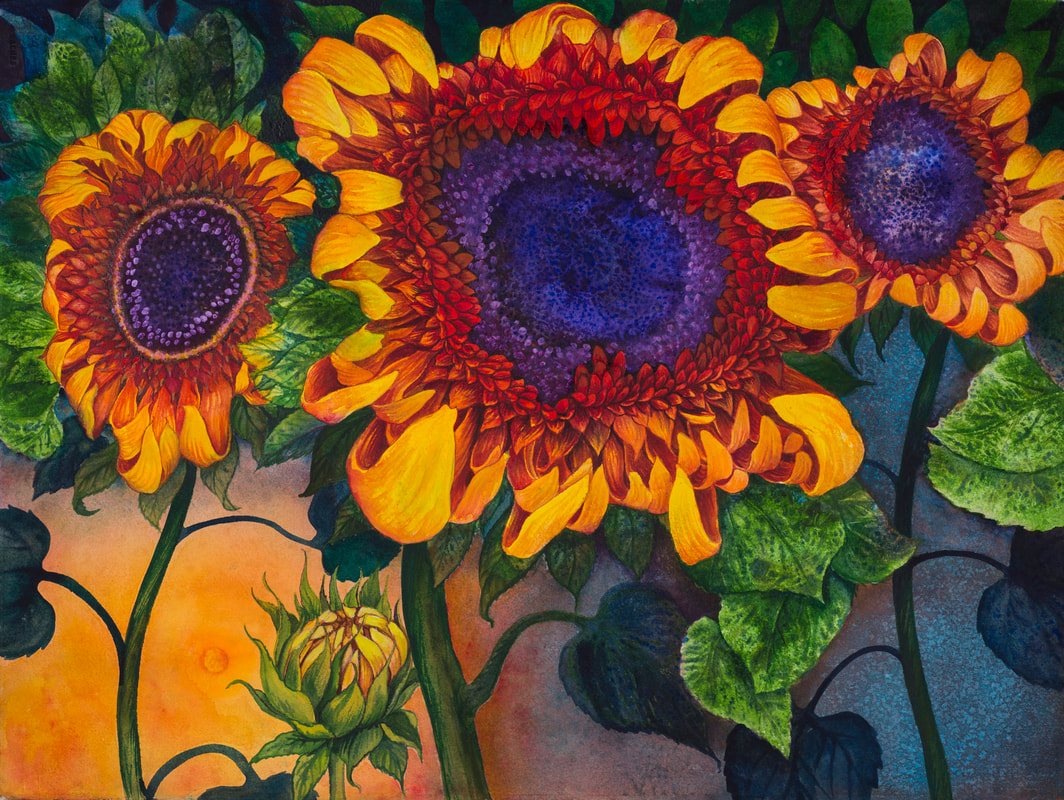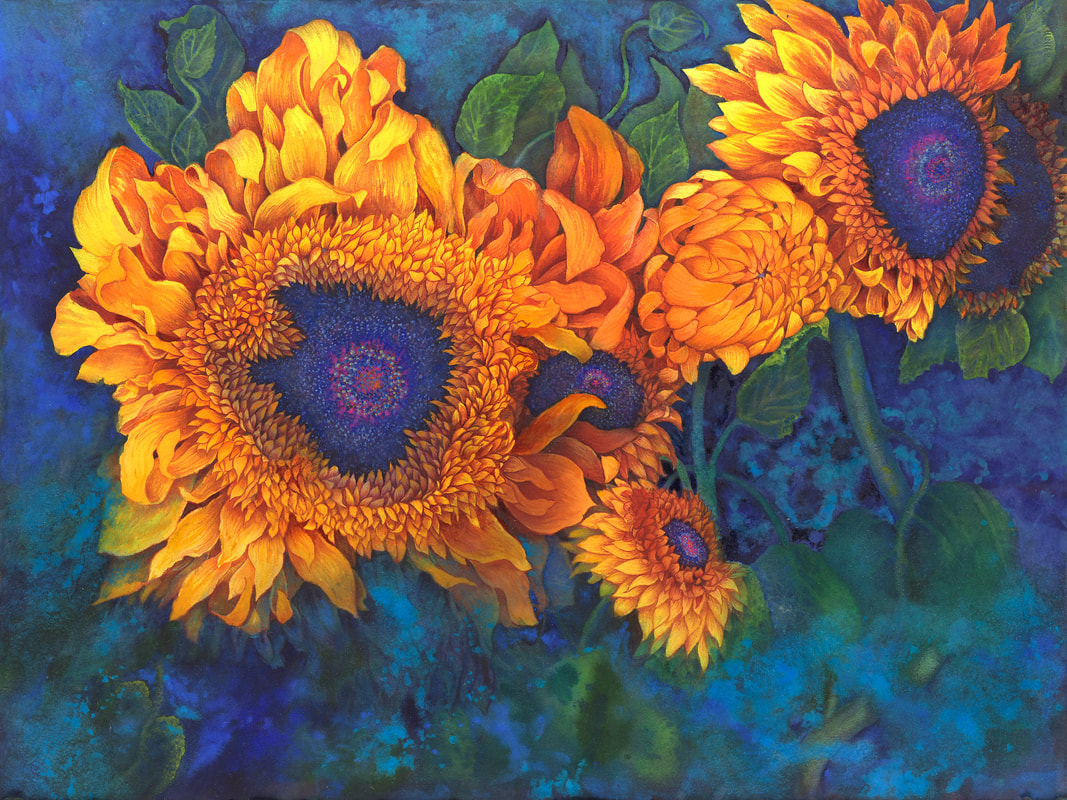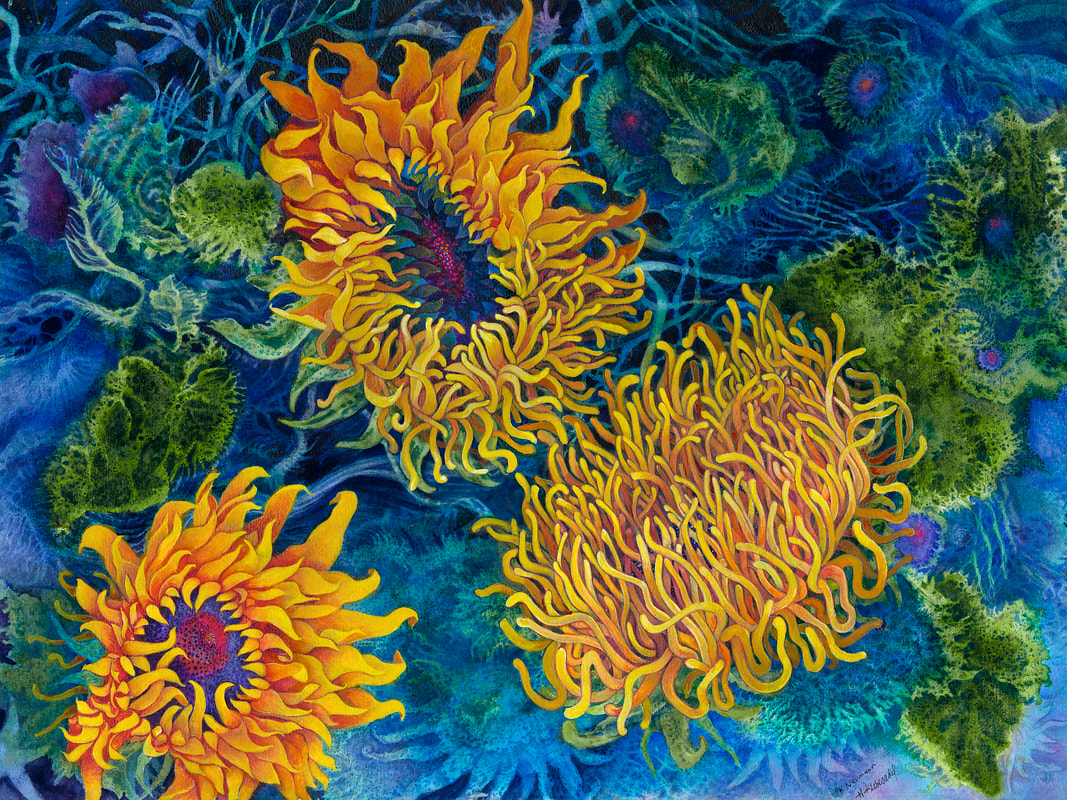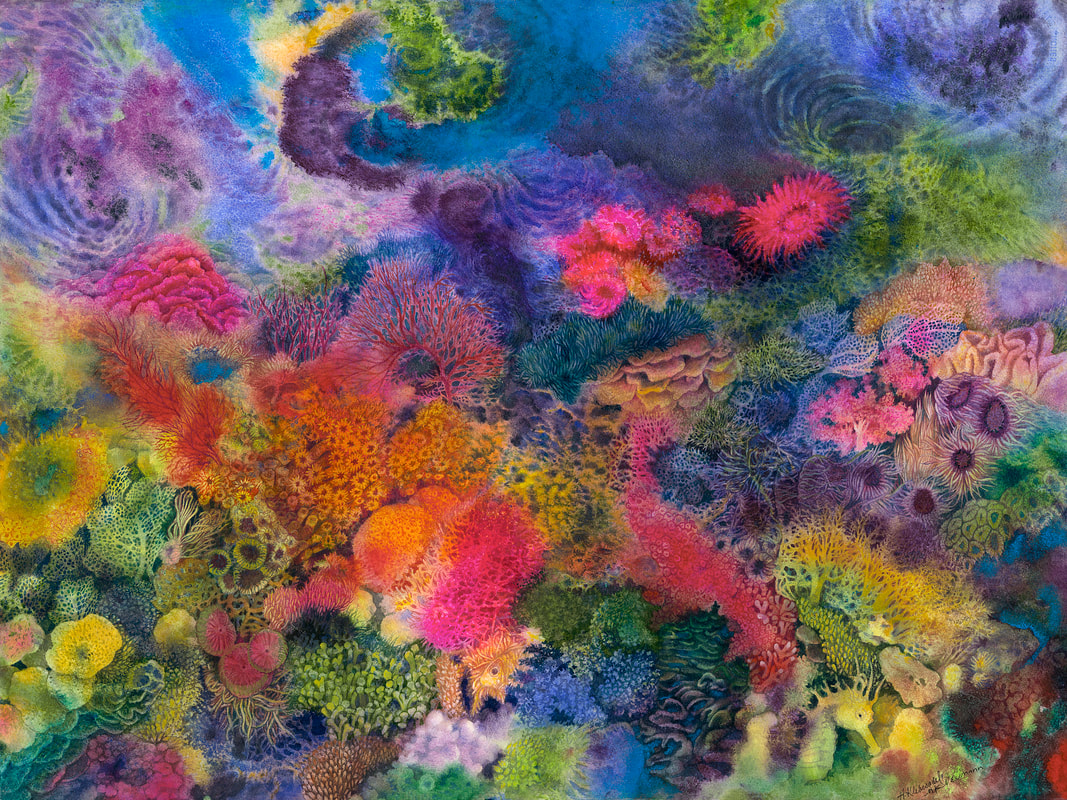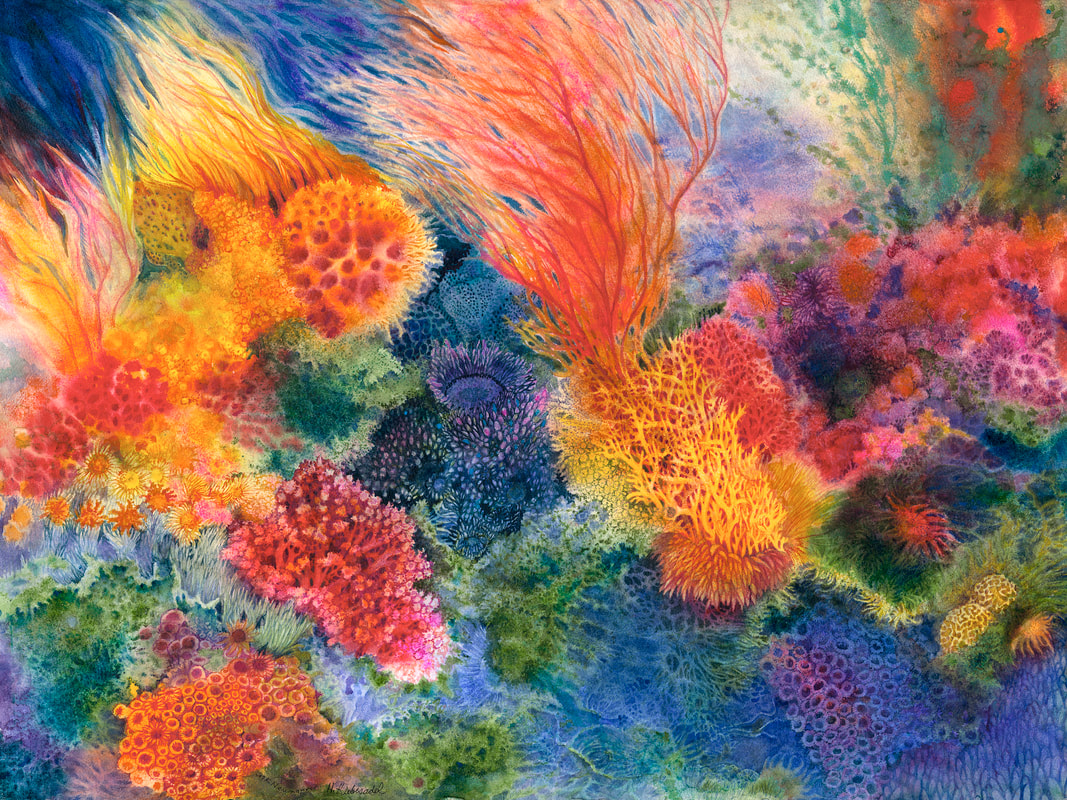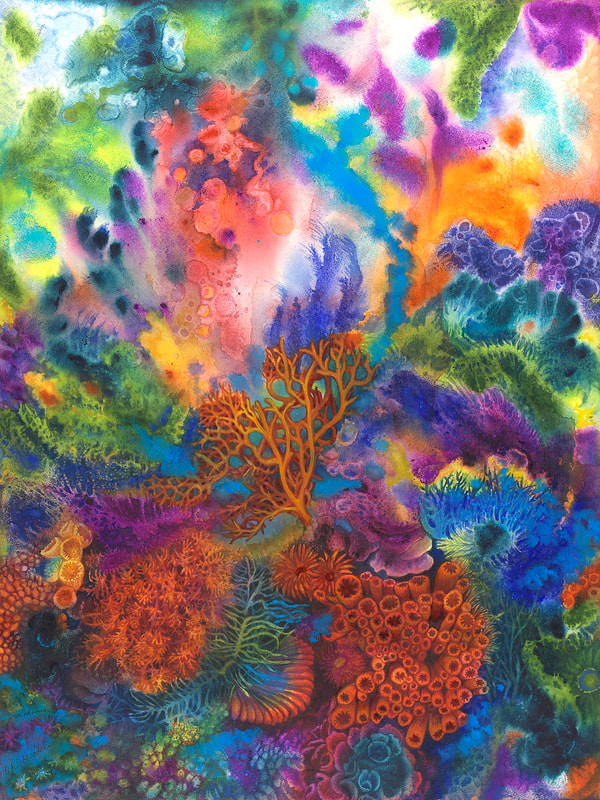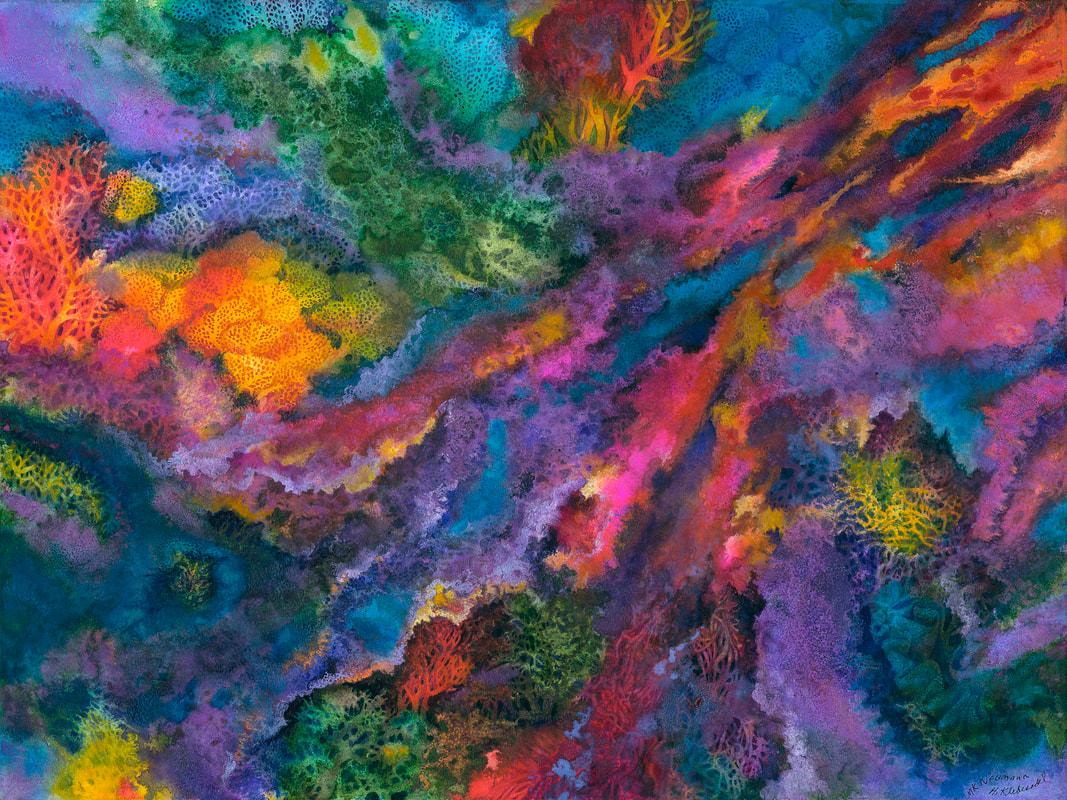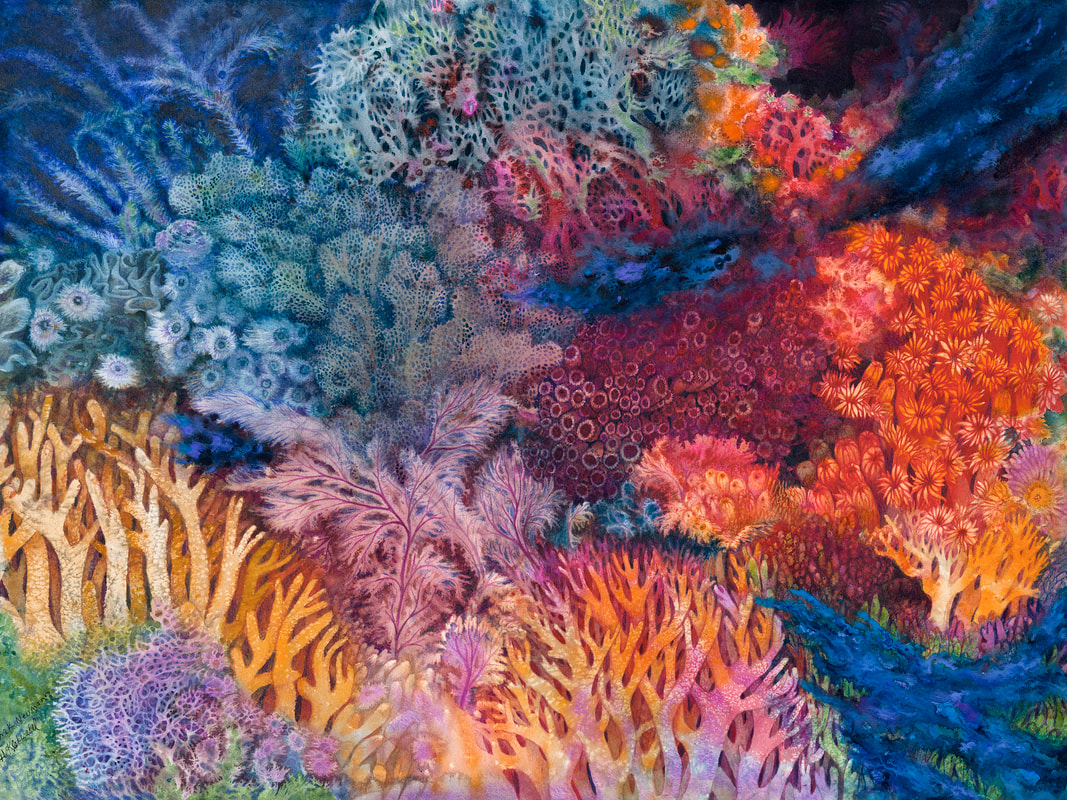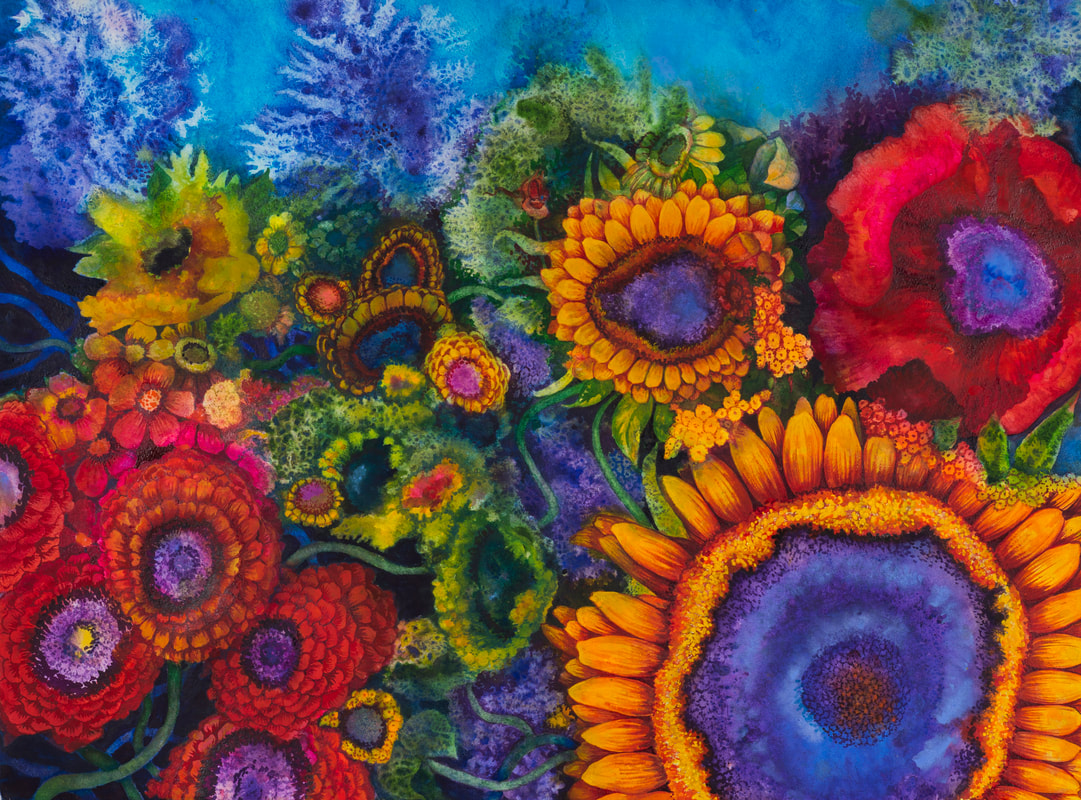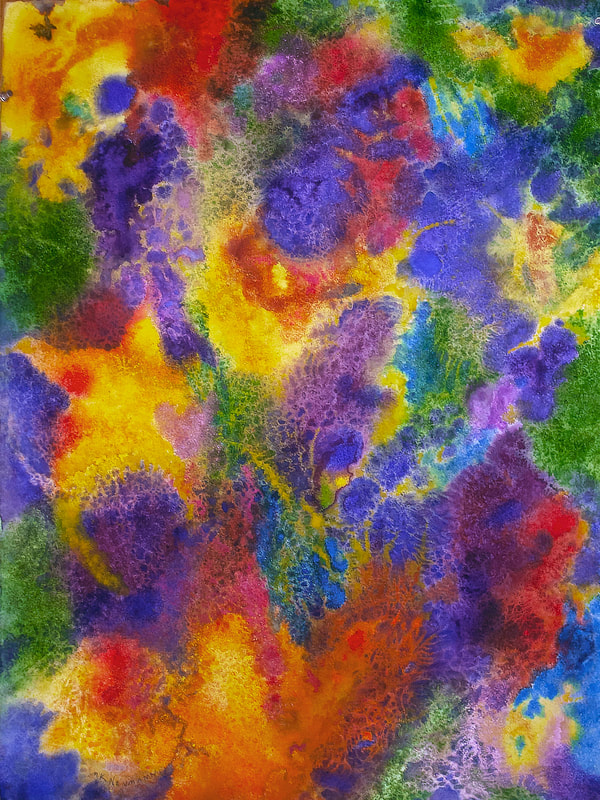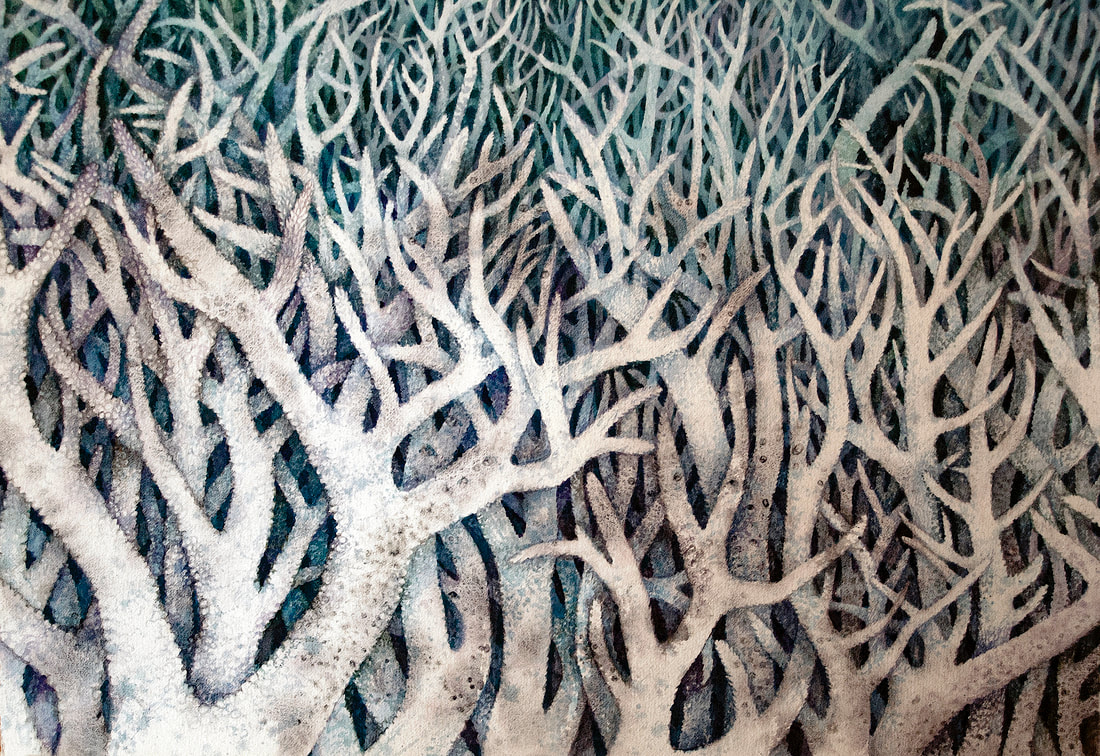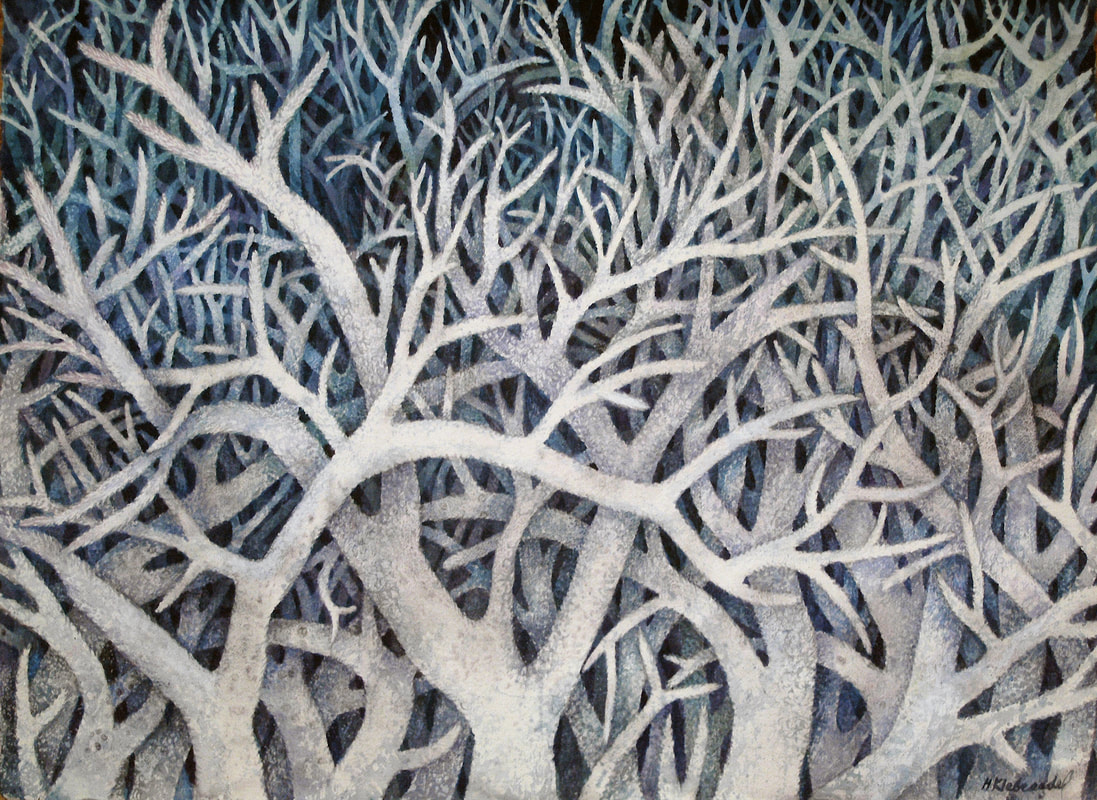THE FLOWERS ARE BURNING
“The Flowers Are Burning… Oceans A Rising:
An Art and Climate Justice Exhibition”
A Collaborative Project
by Helen Klebesadel and Mary Kay Neumann
“The Flowers are Burning: An Art and Climate Justice Project” was launched as a website and a series of exhibitions in 2015. The collaborating artists evoked a sense of alarm at the urgent need to address climate change. Its title holds up the vision of rising from the ashes of a restorative prairie burn.
This exhibition honors the 50th Anniversary of Earth Day. The genesis of “The Flowers Are Burning”, climate change and its consequences, have become even more critical and inescapable in the public eye. The call to action for each of us is more critical today than ever.
Artists Mary Kay Neumann and Helen Klebesadel created this traveling exhibition and climate justice project to bring a more accessible lens through which to approach the devastating consequences of our current climate crises. The artists contend that each individual can do something, (like voting for climate conscious candidates) to use what power and skills we have to make positive change. Using their artworks as a source of strength in the face of adversity, they call upon the power of beauty and love to guide us towards taking action to protect what we love and care deeply about.
“Oceans A Rising” is the current chapter in the in Neumann/Klebesadel collaborative evolution. The focus of their new body of watercolor paintings points to the consequences of our global denial of climate change below the waves: our Ocean’s struggle with over-heated seawaters, acidification, pollution and human sewage that fan the flames of deadly ocean diseases.
One of their topics are coral reefs, the most biologically diverse ecosystems on our planet: they are dying all across the world. Damaging human activities and rising temperatures that coincide with ocean diseases cause coral bleaching, which kills the coral. For some corals, they first express their stress in amazing colors, and then, as the algae life on their surface die from heat, they bleach to white. Science indicates that coral reefs around the world could be mostly wiped out by 2050, and the habitats and greater ecosystems they support — will be gone.
“Oceans A Rising” features collaboratively painted images from the Ocean, speaking the stories that are being lived out underwater. They ask their audience to reach into their hearts, engage with the painful reality of noticing what climate change has endangered in nature… “is there something you love in harm’s way? What are you moved to do in response?” The artists believe that no action is too small, especially when love is the motivation.
The majority of paintings in this exhibition were created collaboratively. These large-scale watercolors were co-painted by Klebesadel and Neumann, passing the paintings back and forth between them. They discovered that while their individual painting styles were very different, the resulting collaborative paintings were unique. The results are not something that either artist could have created alone. An amazing synergy emerged from their shared feminist values, allowing effective cooperation and creative partnership. As they worked on paintings together, they saw the parallel to what is needed in the larger world. As society faces climate problems, people from diverse backgrounds and beliefs must learn to communicate and collaborate well across their differences.
An exhibition was to have taken place at Holy Wisdom Monastery in April 2020. Due to the global pandemic of COVID-19 , a physical exhibition was not possible. A theme running through their paintings points to the outbreak of ocean diseases that tragically has coincided with the coronavirus that is sweeping across the planet above the waters. It seems to reiterate the sense that everything is connected and what we do to the planet we do to ourselves.
The artists believe deeply that humans must embrace the reality that we are all connected to nature…that what happens in the Ocean, on Earth or to any life forms above and below the water, is happening to us as well. Everything is related and we can no longer go forward believing in the superiority of human life over all other life, if we are to survive. The artists sense of urgency is born out of their love of the natural world and the desire to protect and preserve what is left before it is too late,
The artist’s website www.theflowersareburning.com provides education, resources, art/science collaboration, activism....and HOPE for coping with the increasing threat facing the planet. Engaging people to focus on what they love and care about that is threatened by climate change, inspiring them to think about what they are moved to do is the clarion call. Engaging from the heart is necessary to move beyond the despair that climate change evokes....to feel the grief and travel beyond pain towards acting on behalf of what is loved. In this way, love is a source of power and an agent of change.
Klebesadel and Neumann invite you to engage with their paintings, witness the messages being sent from the Ocean, and ponder:
What do YOU love in nature that needs protecting?
What are you moved to DO about it?
This exhibition honors the 50th Anniversary of Earth Day. The genesis of “The Flowers Are Burning”, climate change and its consequences, have become even more critical and inescapable in the public eye. The call to action for each of us is more critical today than ever.
Artists Mary Kay Neumann and Helen Klebesadel created this traveling exhibition and climate justice project to bring a more accessible lens through which to approach the devastating consequences of our current climate crises. The artists contend that each individual can do something, (like voting for climate conscious candidates) to use what power and skills we have to make positive change. Using their artworks as a source of strength in the face of adversity, they call upon the power of beauty and love to guide us towards taking action to protect what we love and care deeply about.
“Oceans A Rising” is the current chapter in the in Neumann/Klebesadel collaborative evolution. The focus of their new body of watercolor paintings points to the consequences of our global denial of climate change below the waves: our Ocean’s struggle with over-heated seawaters, acidification, pollution and human sewage that fan the flames of deadly ocean diseases.
One of their topics are coral reefs, the most biologically diverse ecosystems on our planet: they are dying all across the world. Damaging human activities and rising temperatures that coincide with ocean diseases cause coral bleaching, which kills the coral. For some corals, they first express their stress in amazing colors, and then, as the algae life on their surface die from heat, they bleach to white. Science indicates that coral reefs around the world could be mostly wiped out by 2050, and the habitats and greater ecosystems they support — will be gone.
“Oceans A Rising” features collaboratively painted images from the Ocean, speaking the stories that are being lived out underwater. They ask their audience to reach into their hearts, engage with the painful reality of noticing what climate change has endangered in nature… “is there something you love in harm’s way? What are you moved to do in response?” The artists believe that no action is too small, especially when love is the motivation.
The majority of paintings in this exhibition were created collaboratively. These large-scale watercolors were co-painted by Klebesadel and Neumann, passing the paintings back and forth between them. They discovered that while their individual painting styles were very different, the resulting collaborative paintings were unique. The results are not something that either artist could have created alone. An amazing synergy emerged from their shared feminist values, allowing effective cooperation and creative partnership. As they worked on paintings together, they saw the parallel to what is needed in the larger world. As society faces climate problems, people from diverse backgrounds and beliefs must learn to communicate and collaborate well across their differences.
An exhibition was to have taken place at Holy Wisdom Monastery in April 2020. Due to the global pandemic of COVID-19 , a physical exhibition was not possible. A theme running through their paintings points to the outbreak of ocean diseases that tragically has coincided with the coronavirus that is sweeping across the planet above the waters. It seems to reiterate the sense that everything is connected and what we do to the planet we do to ourselves.
The artists believe deeply that humans must embrace the reality that we are all connected to nature…that what happens in the Ocean, on Earth or to any life forms above and below the water, is happening to us as well. Everything is related and we can no longer go forward believing in the superiority of human life over all other life, if we are to survive. The artists sense of urgency is born out of their love of the natural world and the desire to protect and preserve what is left before it is too late,
The artist’s website www.theflowersareburning.com provides education, resources, art/science collaboration, activism....and HOPE for coping with the increasing threat facing the planet. Engaging people to focus on what they love and care about that is threatened by climate change, inspiring them to think about what they are moved to do is the clarion call. Engaging from the heart is necessary to move beyond the despair that climate change evokes....to feel the grief and travel beyond pain towards acting on behalf of what is loved. In this way, love is a source of power and an agent of change.
Klebesadel and Neumann invite you to engage with their paintings, witness the messages being sent from the Ocean, and ponder:
What do YOU love in nature that needs protecting?
What are you moved to DO about it?
"Burned By The Fire We Make: The Flowers Are Burning Series"
Collaborative Watercolor by Mary Kay Neumann and Helen Klebesadel 22x30
“And when Man gained dominion
Over land and the oceans
He began to harm the planet
With his asphalt and his toxins
And to lay the forest bare
And to poison even the air
And he killed every beast
And taught the seas how to bleed
Burned by the fire we make,
What a shame.
Then the winds gave in
And the rain knew no season
And the sun came to beat
On a land of sand and diseases
And when God looked down
On the earth and saw it was broken
Then the tears of God fell down
Through a hole in the ozone
Burned by the fire we make
What a shame.
This is the nature of the human race
To kill off anything that gets in our way
Poor Mother Earth we disfigured her face
Man is the maker of his own disgrace
Burned by the fire we make
What a shame.”
– Lyrics by Adrian Belew, “Burned by the Fire We Make” Used by permission of Adrian Belew
“And when Man gained dominion
Over land and the oceans
He began to harm the planet
With his asphalt and his toxins
And to lay the forest bare
And to poison even the air
And he killed every beast
And taught the seas how to bleed
Burned by the fire we make,
What a shame.
Then the winds gave in
And the rain knew no season
And the sun came to beat
On a land of sand and diseases
And when God looked down
On the earth and saw it was broken
Then the tears of God fell down
Through a hole in the ozone
Burned by the fire we make
What a shame.
This is the nature of the human race
To kill off anything that gets in our way
Poor Mother Earth we disfigured her face
Man is the maker of his own disgrace
Burned by the fire we make
What a shame.”
– Lyrics by Adrian Belew, “Burned by the Fire We Make” Used by permission of Adrian Belew
"Floating on Denial: Rising Waters Series"
Collaborative Watercolor by Mary Kay Neumann and Helen Klebesadel 22x30
"It is a curious situation that the sea, from which life first arose should now be threatened by the activities of one form of that life. But the sea, though changed in a sinister way, will continue to exist; the threat is rather to life itself.”
– Rachel Carson, The Sea Around Us
“Within a single human existence things are disappearing from the earth, never to be seen again. Our sacred petroglyphs—those carvings in rock that were put there thousands of years ago—are now being put under water by the rising seas. We’ve seen this happen for a long time—this diminishing of our natural resources—through climate change and invasive species. The losses have been slow and multigenerational. We have narrowed our spiritual palettes and our physical palettes to take what we have. But the stories, the old stories that still contain a lot of those elements, hold on to the traditional. For example, our ceremonies and language still include the caribou, even though they don’t live here anymore. Similarly, we know the petroglyphs still exist, but now they’re underwater. The change is in how we acknowledge them”.
– John Bear Mitchell, Penobscot scholar and member of Penobscot Nation in Machiasport Maine (from Rising: Dispatches from the New American Shore by Elizabeth Rush)
"It is a curious situation that the sea, from which life first arose should now be threatened by the activities of one form of that life. But the sea, though changed in a sinister way, will continue to exist; the threat is rather to life itself.”
– Rachel Carson, The Sea Around Us
“Within a single human existence things are disappearing from the earth, never to be seen again. Our sacred petroglyphs—those carvings in rock that were put there thousands of years ago—are now being put under water by the rising seas. We’ve seen this happen for a long time—this diminishing of our natural resources—through climate change and invasive species. The losses have been slow and multigenerational. We have narrowed our spiritual palettes and our physical palettes to take what we have. But the stories, the old stories that still contain a lot of those elements, hold on to the traditional. For example, our ceremonies and language still include the caribou, even though they don’t live here anymore. Similarly, we know the petroglyphs still exist, but now they’re underwater. The change is in how we acknowledge them”.
– John Bear Mitchell, Penobscot scholar and member of Penobscot Nation in Machiasport Maine (from Rising: Dispatches from the New American Shore by Elizabeth Rush)
"A Change is Gonna Come: Tidepools in Peril Series”
Collaborative Watercolor by Mary Kay Neumann and Helen Klebesadel 22x30
"All things are one thing and that one thing is all things…plankton, a shimmering phosphorescence on the sea and the spinning planets and expanding universe, all bound together by the elastic string of time. It is advisable to look from the tidepool to the stars and back to the tidepool again.”
– John Steinbeck, Sea of Cortez
Using artistic license, our sunflowers are being engulfed in seawater, undergoing the process of adapting to the changing conditions of climate...overheated, acidified, polluted water and ocean disease. We imagine these flowers transforming into giant green sea anemones, which we’ve always thought of as underwater sunflowers. Notice the ghostly sunflower seastars, now locally extinct on the West Coast, due to Sea Star Wasting Disease.
“Sea creatures suffer more than land animals in the face of climate change . As the Ocean warms, marine animals experience body temperatures that are near their upper tolerance limit more often than land animals do. Local extinctions—when an animal disappears from specific locations instead of their whole range—of marine animals are also twice as common as they are for land animals.
To help marine animals adapt and survive, we must transition away from our reliance on fossil fuels in order to reduce our greenhouse gas emissions. Greenhouse gases, in particular carbon dioxide, are the driving force behind climate change, both on land and in the ocean. One step the U.S. can take as a nation is to follow through on our emissions reduction pledges, like the one we made as part of the Paris Agreement.
We must also make sure that the ocean is an otherwise safe place for animals to live so that they can adapt as best they can to changing temperatures. That means we need to reduce our plastic use, reduce pollution and sustainably manage our fisheries. And most importantly, we can all vote for leaders who understand and support the need to protect our ocean from the effects of climate change.”
– adapted from Ocean Conservancy website
"All things are one thing and that one thing is all things…plankton, a shimmering phosphorescence on the sea and the spinning planets and expanding universe, all bound together by the elastic string of time. It is advisable to look from the tidepool to the stars and back to the tidepool again.”
– John Steinbeck, Sea of Cortez
Using artistic license, our sunflowers are being engulfed in seawater, undergoing the process of adapting to the changing conditions of climate...overheated, acidified, polluted water and ocean disease. We imagine these flowers transforming into giant green sea anemones, which we’ve always thought of as underwater sunflowers. Notice the ghostly sunflower seastars, now locally extinct on the West Coast, due to Sea Star Wasting Disease.
“Sea creatures suffer more than land animals in the face of climate change . As the Ocean warms, marine animals experience body temperatures that are near their upper tolerance limit more often than land animals do. Local extinctions—when an animal disappears from specific locations instead of their whole range—of marine animals are also twice as common as they are for land animals.
To help marine animals adapt and survive, we must transition away from our reliance on fossil fuels in order to reduce our greenhouse gas emissions. Greenhouse gases, in particular carbon dioxide, are the driving force behind climate change, both on land and in the ocean. One step the U.S. can take as a nation is to follow through on our emissions reduction pledges, like the one we made as part of the Paris Agreement.
We must also make sure that the ocean is an otherwise safe place for animals to live so that they can adapt as best they can to changing temperatures. That means we need to reduce our plastic use, reduce pollution and sustainably manage our fisheries. And most importantly, we can all vote for leaders who understand and support the need to protect our ocean from the effects of climate change.”
– adapted from Ocean Conservancy website
“Gimme Shelter: Coral in Crises Series”
Collaborative Watercolor by Mary Kay Neumann and Helen Klebesadel 22x30
“One quarter of all ocean life depends on the tiny animals that are coral reefs. And they are cooking to death.
“Hidden from view, under the ocean waves, an alarm is going off in glowing color. It’s a warning as devastating as it is beautiful….one we can’t afford to ignore. In a desperate attempt to survive the increasing underwater heat waves caused by the 93% climate-change heat that is absorbed by the ocean, corals produce vibrantly colored chemicals that act as sunscreens to protect themselves from the heat. It is as if the corals are screaming in color; the ultimate warning that the ocean is in trouble.
“We often forget that the Ocean sustains all life on Earth. And few people understand that it is as complex and vulnerable as the human body—even a small change in temperature or chemistry causes vital systems to start shutting down. This is why we should be alarmed when corals start ‘glowing’; this is the indicator of system failure for planet Earth. For the first time in human history, we’re witnessing the collapse of a global-scale ecosystem—coral reefs."
– Richard Vevers, Founder and CEO of The Ocean Agency
Our Series: Coral in Crises is our collaborative translation of the Ocean’s warning through vivid coloring of corals in their last gasp of coral fluorescence before dying.
“One quarter of all ocean life depends on the tiny animals that are coral reefs. And they are cooking to death.
“Hidden from view, under the ocean waves, an alarm is going off in glowing color. It’s a warning as devastating as it is beautiful….one we can’t afford to ignore. In a desperate attempt to survive the increasing underwater heat waves caused by the 93% climate-change heat that is absorbed by the ocean, corals produce vibrantly colored chemicals that act as sunscreens to protect themselves from the heat. It is as if the corals are screaming in color; the ultimate warning that the ocean is in trouble.
“We often forget that the Ocean sustains all life on Earth. And few people understand that it is as complex and vulnerable as the human body—even a small change in temperature or chemistry causes vital systems to start shutting down. This is why we should be alarmed when corals start ‘glowing’; this is the indicator of system failure for planet Earth. For the first time in human history, we’re witnessing the collapse of a global-scale ecosystem—coral reefs."
– Richard Vevers, Founder and CEO of The Ocean Agency
Our Series: Coral in Crises is our collaborative translation of the Ocean’s warning through vivid coloring of corals in their last gasp of coral fluorescence before dying.
“Oye Cómo Va Mi Ritmo (Listen to how my rhythm goes): Coral in Crises Series”
Collaborative Watercolor by Mary Kay Neumann and Helen Klebesadel 22x30
“A healthy reef is alive with music, but the chorus fades as the coral dies. There's a lot of music under the sea. A healthy section of Australia's Great Barrier Reef is full of it—damselfish hooting, clownfish chirping, shrimp clicking their claws. There's this whole sort of orchestra of animals making noise. But when reefs get damaged, animals die and the orchestra stops playing. That silence makes it harder for young fish that have grown up in the open ocean to find a way back to their adult homes, further degrading the already-suffering reefs. A reef without fish is really a reef that's in trouble.
“Sound is part of how fish find their way back to the reef. Fish play vital roles in reef ecosystems, collaborating with other species like anemones in their role as “cleaners” of damaged reef. Some reef fish eat the algae that grows on deed reef, allowing new polyps to help it regenerate. But when reefs fall silent, juvenile fish don’t make their homes there, preventing the reefs from making a least a comeback.
“People shouldn’t despair, but continue to work towards reducing carbon emissions as the long-term solution for helping the reefs”.
– Tim Gordon, PhD, Candidate University of Exeter
“A healthy reef is alive with music, but the chorus fades as the coral dies. There's a lot of music under the sea. A healthy section of Australia's Great Barrier Reef is full of it—damselfish hooting, clownfish chirping, shrimp clicking their claws. There's this whole sort of orchestra of animals making noise. But when reefs get damaged, animals die and the orchestra stops playing. That silence makes it harder for young fish that have grown up in the open ocean to find a way back to their adult homes, further degrading the already-suffering reefs. A reef without fish is really a reef that's in trouble.
“Sound is part of how fish find their way back to the reef. Fish play vital roles in reef ecosystems, collaborating with other species like anemones in their role as “cleaners” of damaged reef. Some reef fish eat the algae that grows on deed reef, allowing new polyps to help it regenerate. But when reefs fall silent, juvenile fish don’t make their homes there, preventing the reefs from making a least a comeback.
“People shouldn’t despair, but continue to work towards reducing carbon emissions as the long-term solution for helping the reefs”.
– Tim Gordon, PhD, Candidate University of Exeter
“Screaming in Color: Coral in Crises Series”
Collaborative Watercolor by Mary Kay Neumann and Helen Klebesadel 22x15
Corals are invertebrate animals that belong to a large group called Cnidaria (like the sea anemone and jellyfish). They are symbiotic and have mutual and beneficial relationships with other organisms to survive. Living reefs are the homes for thousands of tiny animals, known as coral polyps. They live amongst the skeletal remains of their ancestors on the coral. The polyps have a symbiotic relationship with algae called zooxanthellae . These tiny algae live inside a coral polyp’s tissues. They’re what give coral its bright color. The algae use sunlight to make sugar. This feeds not only the algae, but also the coral polyp.
The symbiotic zooxanthellae of coral are often brownish or green because of the photosynthetic pigment called “chlorophyll”. Like with deciduous tree leaves, the chlorophyll is responsible for the brown or green coloration. There are also more then 85 fluorescent pigments that can be produced by corals.
Some corals increase the production of colorful protein pigments when they are exposed to bright sunlight or heat. Pink and purple proteins act as sunscreens for the corals by administering protection for coral against the damaging effects of UV rays. When the zooxanthellae cells convert light to chlorophyll, the biological process manufactures a life-giving supply of oxygen. Corals may change their color (like to blue, violet, red) to adapt to different light conditions and water temperature. The brighter the color of the coral, the more oxygen is being produced.
Corals can decrease or increase the chlorophyll production from the zooxanthellae cells depending on environmental requirements. Healthy coral has subtle earthy tones. The brighter fluorescent tones we have become accustomed to seeing are actually a sign that the coral is going through heat stress. Under heat stress conditions there is initially a spike in fluorescence and then a decline as the corals bleach.
Corals are screaming in color. Will we hear them?
Corals are invertebrate animals that belong to a large group called Cnidaria (like the sea anemone and jellyfish). They are symbiotic and have mutual and beneficial relationships with other organisms to survive. Living reefs are the homes for thousands of tiny animals, known as coral polyps. They live amongst the skeletal remains of their ancestors on the coral. The polyps have a symbiotic relationship with algae called zooxanthellae . These tiny algae live inside a coral polyp’s tissues. They’re what give coral its bright color. The algae use sunlight to make sugar. This feeds not only the algae, but also the coral polyp.
The symbiotic zooxanthellae of coral are often brownish or green because of the photosynthetic pigment called “chlorophyll”. Like with deciduous tree leaves, the chlorophyll is responsible for the brown or green coloration. There are also more then 85 fluorescent pigments that can be produced by corals.
Some corals increase the production of colorful protein pigments when they are exposed to bright sunlight or heat. Pink and purple proteins act as sunscreens for the corals by administering protection for coral against the damaging effects of UV rays. When the zooxanthellae cells convert light to chlorophyll, the biological process manufactures a life-giving supply of oxygen. Corals may change their color (like to blue, violet, red) to adapt to different light conditions and water temperature. The brighter the color of the coral, the more oxygen is being produced.
Corals can decrease or increase the chlorophyll production from the zooxanthellae cells depending on environmental requirements. Healthy coral has subtle earthy tones. The brighter fluorescent tones we have become accustomed to seeing are actually a sign that the coral is going through heat stress. Under heat stress conditions there is initially a spike in fluorescence and then a decline as the corals bleach.
Corals are screaming in color. Will we hear them?
"Stop! In the Name Love: Tidepools in Peril Series "
Collaborative Watercolor by Mary Kay Neumann and Helen Klebesadel 22x30
“I study collapsed civilizations. Here’s my advice for a climate change apocalypse:
While the wilderness survival skills certainly can’t hurt, it will be empathy, generosity, and courage that we need to survive. Kindness and fairness will be more valuable than any survival skill. Then as now, social and leadership skills will be valued. We will have to work together. We will have to grow food, educate ourselves, and give people a reason to persevere. The needs will be enormous, and we cannot run away from that. Humans evolved attributes such as generosity, altruism, and cooperation because we need them to survive. Armed with those skills, we will turn towards the problem, not away from it. We will face the need, and we will have to solve it together. That is the only option. That’s what survival looks like.”
– Dr. Chris Begley, Associate Professor of Anthropology, Transylvania University, Lexington, Kentucky, archaeologist and wilderness survival instructor.
“I study collapsed civilizations. Here’s my advice for a climate change apocalypse:
While the wilderness survival skills certainly can’t hurt, it will be empathy, generosity, and courage that we need to survive. Kindness and fairness will be more valuable than any survival skill. Then as now, social and leadership skills will be valued. We will have to work together. We will have to grow food, educate ourselves, and give people a reason to persevere. The needs will be enormous, and we cannot run away from that. Humans evolved attributes such as generosity, altruism, and cooperation because we need them to survive. Armed with those skills, we will turn towards the problem, not away from it. We will face the need, and we will have to solve it together. That is the only option. That’s what survival looks like.”
– Dr. Chris Begley, Associate Professor of Anthropology, Transylvania University, Lexington, Kentucky, archaeologist and wilderness survival instructor.
"Subterranean Homesick Blues: Corals in Crises Series"
Collaborative Watercolor by Mary Kay Neumann and Helen Klebesadel 22x30
I was just born, I was just born
I've been crawling till I learned to walk
When I met you I was so young
I didn't know that it could fall apart.
Tell me what do I do
Now I see what we have done
And I know that it's true
You give me nothing but love.
I been trying, I been trying
To tell you what's inside my soul
I've been dying, I've been dying
But the ocean changes slow.
And it’s hard to see it
But I know that it’s true
That I got to be better
So much better to you.
I scream in color
Tell me, can you hear me through the waves?
If we keep on waiting
Do we lose the things that we can save?
If we hold each other
We don't have to let it slip away…
We don't have to let this
Slip away.
Tell me how long, tell me how long
Till we see the pieces that'll break?
Tell me how long, tell me how long
Till we wake up?
Till we wake up?
Tell me how long, tell me how long
Till we wake up?
– Adapted from "Tell Me How Long"(from the Netflix documentary "Chasing Coral" soundtrack) by Dan Romer and Teddy Geiger
I was just born, I was just born
I've been crawling till I learned to walk
When I met you I was so young
I didn't know that it could fall apart.
Tell me what do I do
Now I see what we have done
And I know that it's true
You give me nothing but love.
I been trying, I been trying
To tell you what's inside my soul
I've been dying, I've been dying
But the ocean changes slow.
And it’s hard to see it
But I know that it’s true
That I got to be better
So much better to you.
I scream in color
Tell me, can you hear me through the waves?
If we keep on waiting
Do we lose the things that we can save?
If we hold each other
We don't have to let it slip away…
We don't have to let this
Slip away.
Tell me how long, tell me how long
Till we see the pieces that'll break?
Tell me how long, tell me how long
Till we wake up?
Till we wake up?
Tell me how long, tell me how long
Till we wake up?
– Adapted from "Tell Me How Long"(from the Netflix documentary "Chasing Coral" soundtrack) by Dan Romer and Teddy Geiger
“Silent Spring: Tidepools in Peril Series”
Collaborative Watercolor by Mary Kay Neumann and Helen Klebesadel 22x30
“Those who contemplate the beauty of the earth find reserves of strength that will endure as long as life lasts. There is something infinitely healing in the repeated refrains of nature -- the assurance that dawn comes after night, and spring after winter.”
– Rachel Carson, Silent Spring
“Those who contemplate the beauty of the earth find reserves of strength that will endure as long as life lasts. There is something infinitely healing in the repeated refrains of nature -- the assurance that dawn comes after night, and spring after winter.”
– Rachel Carson, Silent Spring
“The Last Waltz: Melting Sea Star Series”
Mary Kay Neumann, Watercolor 30x40
Many years ago, I was approached by a sunflower sea star, as I waded in the shallow waters of the Pacific Ocean at very low tide. Traveling rapidly for a tide pool creature, it moved towards me as I remained perfectly still. It touched my shoe, my pant leg and examined my leg as far as it could reach for several minutes. Eventually, it moved away back under the kelp, disappearing into the ocean.
As an artist, I’ve loved the sunflowers of Van Gogh, and have been painting them for 20 years. Discovering a different kind of sunflower that lived in the tidepool landscape was an unexpected delight. A 24-legged starfish that can span 2 feet across, in colors of orange, purple, hot pink, and yellow, was an artist's dream come true. To be approached by one on that beautiful low-tide April morning was one of the most beautiful moments of my life.
These voracious ocean predators are a “keystone species”. At the top of the food chain, they reign over all the other creatures in a tidepool. A healthy sunflower sea star (commonly called starfish) has up to 24 limbs, called “rays,” and grip onto surfaces with impressive strength. Each individual has 15,000 delicate suction-cupped tube feet for locomotion and prying open hard-shelled prey such as oysters, clams, barnacles and sea urchins. The sunflower sea star keeps other species in check, maintaining a balance in these fragile marine ecosystems.
Sunflower sea stars are now nearly extinct on the West Coast of North America. Sea Star Wasting Disease, an ocean disease, began in 2014 and has killed most all the sunflower sea stars. This ocean outbreak is the single largest-scale marine die-off ever recorded. This marine disease attacks not only the sunflower sea star but most other species of sea stars as well. They first develop lesions, arms detach from the central disc, collapsing and literally dissolve into piles of disconnected limbs as the animal dies. One scientist described to me the underwater scene as she dove during the beginning of the outbreak, as a “horror show”. Previously covering the ocean floor with their beautiful bodies, the sunflower sea stars have now actually melted.
The disappearance of the mighty sunflower sea stars causes a domino effect on the rest of the ocean. As the biggest predator of sea urchins, the death of these keystone species has caused a runaway population explosion of sea urchin. This takeover of sea urchins, who decimate the kelp, have turned once luxurious, magnificent kelp forests into a wasteland, stealing food and shelter of countless other marine animals and sea life. What is left behind are “sea urchin barrens”…areas nearly devoid of life. “It’s like seeing a forest you once knew turn into a desert” says one scientist.
Sea otters also eat sea urchins but they need the kelp forests for shelter and protection. In Northern California, the once magnificent bull kelp forests necessary to the survival of otters were mowed down to the ocean floor by the urchins, and the otters disappeared, no longer able to help keep the urchin population in check. This devastating cascade of events that started with the death of sunflower sea stars has left behind an environmental catastrophe. According to Dr. Drew Harvell, Marine Ecologist from Cornell University, this outbreak of disease was “keystone species removal on a truly epic scale”.
This painting in my “Melting Sea Star Series” is an homage to the sunflower sea stars. It depicts them in their time of crises, during the “melting” phase of Sea Star Wasting Disease, where they are barely recognizable shapes, only hinting at the forms they once were. The heartbreaking process of disintegration continues as the disease dissolves these amazing animals that I fell in love with those many years ago.
The balance to the entire chain of life in the ocean is at risk. The health of the ocean is directly connected to the stability of life for the entire planet. Can we pay attention to what the ocean may be saying to us, as we face the pandemic of COVID-19? Humans are THE keystone species on land and our survival is intimately connected with the sea stars, the kelp, the coral. Can we call upon our love for one another other and of the natural world to save us?
Many years ago, I was approached by a sunflower sea star, as I waded in the shallow waters of the Pacific Ocean at very low tide. Traveling rapidly for a tide pool creature, it moved towards me as I remained perfectly still. It touched my shoe, my pant leg and examined my leg as far as it could reach for several minutes. Eventually, it moved away back under the kelp, disappearing into the ocean.
As an artist, I’ve loved the sunflowers of Van Gogh, and have been painting them for 20 years. Discovering a different kind of sunflower that lived in the tidepool landscape was an unexpected delight. A 24-legged starfish that can span 2 feet across, in colors of orange, purple, hot pink, and yellow, was an artist's dream come true. To be approached by one on that beautiful low-tide April morning was one of the most beautiful moments of my life.
These voracious ocean predators are a “keystone species”. At the top of the food chain, they reign over all the other creatures in a tidepool. A healthy sunflower sea star (commonly called starfish) has up to 24 limbs, called “rays,” and grip onto surfaces with impressive strength. Each individual has 15,000 delicate suction-cupped tube feet for locomotion and prying open hard-shelled prey such as oysters, clams, barnacles and sea urchins. The sunflower sea star keeps other species in check, maintaining a balance in these fragile marine ecosystems.
Sunflower sea stars are now nearly extinct on the West Coast of North America. Sea Star Wasting Disease, an ocean disease, began in 2014 and has killed most all the sunflower sea stars. This ocean outbreak is the single largest-scale marine die-off ever recorded. This marine disease attacks not only the sunflower sea star but most other species of sea stars as well. They first develop lesions, arms detach from the central disc, collapsing and literally dissolve into piles of disconnected limbs as the animal dies. One scientist described to me the underwater scene as she dove during the beginning of the outbreak, as a “horror show”. Previously covering the ocean floor with their beautiful bodies, the sunflower sea stars have now actually melted.
The disappearance of the mighty sunflower sea stars causes a domino effect on the rest of the ocean. As the biggest predator of sea urchins, the death of these keystone species has caused a runaway population explosion of sea urchin. This takeover of sea urchins, who decimate the kelp, have turned once luxurious, magnificent kelp forests into a wasteland, stealing food and shelter of countless other marine animals and sea life. What is left behind are “sea urchin barrens”…areas nearly devoid of life. “It’s like seeing a forest you once knew turn into a desert” says one scientist.
Sea otters also eat sea urchins but they need the kelp forests for shelter and protection. In Northern California, the once magnificent bull kelp forests necessary to the survival of otters were mowed down to the ocean floor by the urchins, and the otters disappeared, no longer able to help keep the urchin population in check. This devastating cascade of events that started with the death of sunflower sea stars has left behind an environmental catastrophe. According to Dr. Drew Harvell, Marine Ecologist from Cornell University, this outbreak of disease was “keystone species removal on a truly epic scale”.
This painting in my “Melting Sea Star Series” is an homage to the sunflower sea stars. It depicts them in their time of crises, during the “melting” phase of Sea Star Wasting Disease, where they are barely recognizable shapes, only hinting at the forms they once were. The heartbreaking process of disintegration continues as the disease dissolves these amazing animals that I fell in love with those many years ago.
The balance to the entire chain of life in the ocean is at risk. The health of the ocean is directly connected to the stability of life for the entire planet. Can we pay attention to what the ocean may be saying to us, as we face the pandemic of COVID-19? Humans are THE keystone species on land and our survival is intimately connected with the sea stars, the kelp, the coral. Can we call upon our love for one another other and of the natural world to save us?
“I Can’t Stand Losing You: Melting Sea Star Series”
Mary Kay Neumann, Watercolor 30x22
When I traveled to the West Coast in 2015, I visited the tide pools hoping to find a healthy starfish. Looking out over the mussel beds that should have been covered with their colorful bodies, I was joined by a woman who lived nearby. She mentioned how beautiful it was to see the tidepools. I asked her, “Do you notice anything missing?” She stopped for a few moments and looked around and said, “Where are the starfish?”
Millions of sea stars have died on the Pacific Coast from Sea Star Wasting Disease beginning in 2014, in what scientists call the single largest, most-geographically widespread marine disease ever recorded. It was a “lightning strike hammering the entire guild of West Coast starfish…a huge and horrific loss*".
While it is estimated that 95% of adult sea stars have died along the West Coast, hope is still alive. Different species of sea stars, such as the common ochre sea star, are slowly starting to make a comeback. Juvenile sunflower sea stars have been found that have survived this devastating disease, and there is hope they can live to adulthood. While there is some optimism that the sea star population may recover, it is unlikely they can reach levels seen prior to the outbreak. We need to take immediate action to save them by supporting long term ecosystem monitoring projects, organizations that conduct them and private and public foundations that financially support them. Most importantly, we need to endorse government policies that support science and immediately address the climate crises. As a democracy we need to use the power of our vote.
“…The starfish epidemic has been a turning point for me and many others…With the threat of the imminent extinction of tropical corals, white abalone and our sunflower star, and their cascading ecological impacts, we have crossed a line in the sand. As a society we can no longer stand by idly. We have let loose many destructive forces over which we have little control, but science can still make a difference.”
– Dr Drew Harvell, Professor of Marine Ecology at Cornell, author, Ocean Outbreak: Confronting the Rising Tide of Marine Disease*
When I traveled to the West Coast in 2015, I visited the tide pools hoping to find a healthy starfish. Looking out over the mussel beds that should have been covered with their colorful bodies, I was joined by a woman who lived nearby. She mentioned how beautiful it was to see the tidepools. I asked her, “Do you notice anything missing?” She stopped for a few moments and looked around and said, “Where are the starfish?”
Millions of sea stars have died on the Pacific Coast from Sea Star Wasting Disease beginning in 2014, in what scientists call the single largest, most-geographically widespread marine disease ever recorded. It was a “lightning strike hammering the entire guild of West Coast starfish…a huge and horrific loss*".
While it is estimated that 95% of adult sea stars have died along the West Coast, hope is still alive. Different species of sea stars, such as the common ochre sea star, are slowly starting to make a comeback. Juvenile sunflower sea stars have been found that have survived this devastating disease, and there is hope they can live to adulthood. While there is some optimism that the sea star population may recover, it is unlikely they can reach levels seen prior to the outbreak. We need to take immediate action to save them by supporting long term ecosystem monitoring projects, organizations that conduct them and private and public foundations that financially support them. Most importantly, we need to endorse government policies that support science and immediately address the climate crises. As a democracy we need to use the power of our vote.
“…The starfish epidemic has been a turning point for me and many others…With the threat of the imminent extinction of tropical corals, white abalone and our sunflower star, and their cascading ecological impacts, we have crossed a line in the sand. As a society we can no longer stand by idly. We have let loose many destructive forces over which we have little control, but science can still make a difference.”
– Dr Drew Harvell, Professor of Marine Ecology at Cornell, author, Ocean Outbreak: Confronting the Rising Tide of Marine Disease*
"The Sounds of Silence I: Coral in Crises Series"
Helen Klebesadel, watercolor, 22x30
Coral reefs are some of the most vibrant marine ecosystems on the planet. Between 25% and 33% of all marine species rely on the coral reefs at some point in their life cycle.
Corals and their zooxanthellae thrive in warm tropical waters. But when the water gets too hot, the tiny algae become damaged, causing corals to expel them. Without their colorful companions, the coral polyps become transparent. The bone-like framework the polyps live in shows through. The reef turns white, or bleaches. If the water stays too warm for too long the polyps don’t get enough food and, eventually, they die. The sound-making animals that had lived around the reef search for a new home leaving behind a barren and silent reef.
Warm ocean temperatures are the main driver of coral bleaching. In March of 2020 Australia's Great Barrier Reef has experienced its most widespread bleaching event on record. This is the third mass bleaching event on the reef in just the last five years. Bleaching doesn't kill coral immediately, but if temperatures remain high, eventually the coral will die, destroying a natural habitat for many species of marine life.
“Though researchers around the world are exploring ways to revive reefs those efforts will not be enough if we don't address the root cause of their demise -- human-caused climate change. We have to address climate change if we want to have coral reefs in the future.”
– Dr. C. Mark Eakin, coordinator of the National Oceanic and Atmospheric Administration's (NOAA) Coral Reef Watch
Coral reefs are some of the most vibrant marine ecosystems on the planet. Between 25% and 33% of all marine species rely on the coral reefs at some point in their life cycle.
Corals and their zooxanthellae thrive in warm tropical waters. But when the water gets too hot, the tiny algae become damaged, causing corals to expel them. Without their colorful companions, the coral polyps become transparent. The bone-like framework the polyps live in shows through. The reef turns white, or bleaches. If the water stays too warm for too long the polyps don’t get enough food and, eventually, they die. The sound-making animals that had lived around the reef search for a new home leaving behind a barren and silent reef.
Warm ocean temperatures are the main driver of coral bleaching. In March of 2020 Australia's Great Barrier Reef has experienced its most widespread bleaching event on record. This is the third mass bleaching event on the reef in just the last five years. Bleaching doesn't kill coral immediately, but if temperatures remain high, eventually the coral will die, destroying a natural habitat for many species of marine life.
“Though researchers around the world are exploring ways to revive reefs those efforts will not be enough if we don't address the root cause of their demise -- human-caused climate change. We have to address climate change if we want to have coral reefs in the future.”
– Dr. C. Mark Eakin, coordinator of the National Oceanic and Atmospheric Administration's (NOAA) Coral Reef Watch
"The Sounds of Silence II: Coral in Crises Series"
Helen Klebesadel, watercolor, 22x30
As heat waves and general warming persists world-wide, the ocean temperatures rise. The warming oceans causes corals to lose their color, or bleach. It’s the first sign that the corals are dying. Fish then leave, looking for healthier sites. Without the fish activity, reefs fall silent.
A recent study by found that playing the sounds of a healthy reef can attract fish back to dead or dying areas. Indeed, those sounds could help bring a reef back to life. Dr. Tim Gordon, marine biologist, University of Exeter in England records and studies the relationship of sound to the maintenance of healthy and bleached coral reefs.
Sounds of a healthy reef and impacted reef can be found here:
https://www.smithsonianmag.com/smart-news/listen-sounds-dying-coral-reef-180953543/
“It is critical to remember that the most powerful tool we have is to stop the rapid progression of climate change. Reef restoration won’t last long if people continue to burn fossil fuels. Burning fossil fuels releases carbon in the form of carbon dioxide, a greenhouse gas. The best thing teens can do for coral reefs is to educate themselves and, if old enough, vote for politicians who appreciate and will act on the dangers of climate change.”
– Dr. Jordan Hollarsmith, marine ecologist, Simon Fraser University in Burnaby, British Columbia, Canada
As heat waves and general warming persists world-wide, the ocean temperatures rise. The warming oceans causes corals to lose their color, or bleach. It’s the first sign that the corals are dying. Fish then leave, looking for healthier sites. Without the fish activity, reefs fall silent.
A recent study by found that playing the sounds of a healthy reef can attract fish back to dead or dying areas. Indeed, those sounds could help bring a reef back to life. Dr. Tim Gordon, marine biologist, University of Exeter in England records and studies the relationship of sound to the maintenance of healthy and bleached coral reefs.
Sounds of a healthy reef and impacted reef can be found here:
https://www.smithsonianmag.com/smart-news/listen-sounds-dying-coral-reef-180953543/
“It is critical to remember that the most powerful tool we have is to stop the rapid progression of climate change. Reef restoration won’t last long if people continue to burn fossil fuels. Burning fossil fuels releases carbon in the form of carbon dioxide, a greenhouse gas. The best thing teens can do for coral reefs is to educate themselves and, if old enough, vote for politicians who appreciate and will act on the dangers of climate change.”
– Dr. Jordan Hollarsmith, marine ecologist, Simon Fraser University in Burnaby, British Columbia, Canada
Closing Statement for The Flowers Are Burning… Oceans A Rising
Everything Has Changed
The artists thank you for viewing our exhibition. As mentioned earlier, this new body of work that is focused on threats to our oceans and the creatures that inhabit it, was originally intended for a physical exhibition from April-June, 2020 at the Holy Wisdom Monastery Gallery in Middleton, Wisconsin.
Our exhibition shares our love of the oceans and our recognition that what we do to the oceans we do to ourselves. That recognition has become even clearer as the novel coronavirus Covid-19 has disrupted our lives globally, sickening huge numbers of people and killing people near and far. Everything has changed. Whatever is normal after this will be a new normal. It is up to us to make it a normal we can live with.
Warming threatens the oceans and its life, but infectious disease is clearly a part of the problem too. We have worked hard to establish our call for help in taking the actions we need to in order to stem the ocean warming that results in bleaching and the loss of symbiotic algae and the death of vast stretches of coral reef. However, “Heat stress and loss of required symbionts are bad for coral and by themselves can cause death to the coral, but the combination of stresses also leads to opportunistic infections that continue the killing. Without disease, the bleaching events would be less lethal and fewer corals would die in the years between events. The world’s coral reefs, our most diverse and valuable marine ecosystems, are being sickened by a variety of factors all at once. Our only chance to limit their loss lies in understanding how all the threats to coral interact with and affect each other.*”
The same can be said for humans, everything is connected. In order to live in a sustainable global human community, we must make a world where lower levels of stress mean lower vulnerability to health-related challenges we share as a human species too. At a minimum we must work for clean and sustainable environment. We need sustainable and equitable socioeconomic development for all, that includes basic needs such as safe lodging, clean and healthy foods, universal healthcare, and access to education for all people.
We must take immediate action to reduce carbon emissions requiring a massive transformation in how we produce and consume electricity. We need a newer, better transportation system. We need to stop deforestation. We need a climate-friendly agricultural system.
First steps are electing leaders who will guide us to a future we would like to live in. We must demand that our governments make decisions that look to a sustainable future for all of us, not short-term immediate wealth for a few. We must have a government that relies on science.
We spoke with scientists personally about what message they most want us to convey. Their response was “Vote for candidates that believe in science”. Please remember this in November when you cast your vote.
“If it is a terrifying thought that life is at the mercy of the multiplication of the minute bodies, it is a consoling hope that science will not always remain powerless before such enemies” – Louis Pasteur
We want to reiterate the most important message as we care for each other during this pandemic:
We need to nourish a vision that human and planetary restoration is interconnected. “As our imagination is ignited and the vision settles toward action, we can be certain that recent scientific advances have given us all we need to bring these visions into manifestation. In addition, our inherent neurobiology will support any moves we make in the direction of greater care for each other and our earthly home. Perhaps the magnitude of our current crises – political and environmental – can provide the impetus to focus our beautiful minds on these tasks that matter most.” – Bonnie Badenoch, author, “The Heart of Trauma”
Let us acknowledge that humans are not the only species that matters and require care. Let us show through our actions that we now understand that the well-being of human and non-human species, on land and in our oceans, is intrinsically connected.”
Please visit our website to find the organizations and projects already working on the issues most important to you. We know there are people working everywhere for a sustainable future.
This exhibition was originally timed to be a part of a larger recognition of the 50th Anniversary of the establishment of Earth Day by Senator and Wisconsin Governor Gaylord Nelson in 1970. This exhibition was part of a year-long recognition of Earth Day through the arts organized by the Nelson Institute of the University of Wisconsin-Madison. We thank the Holy Wisdom Monastery and Gallery Curator Rachel Olson, for their ongoing efforts to bring the arts into our conversations about living whole, sustainable and spiritually centered lives and the Nelson Institute for supporting our efforts. We also especially thank Daniel Torres, Akeem Torres, Kim Wilson and Bonnie Badenoch for their support.
*“Ocean Outbreak: Confronting the Rising Tide of Marine Diseases.” by Dr. Drew Harvell
Please enjoy this review of Oceans A Rising entitled Warning Signs: A powerful Earth Day exhibit goes digital, by Catherine Capellaro, published in Isthmus Online, April 13, 2020
|
This exhibition is a part of the University of Wisconsin- Madison Nelson Institute's Earth Day @ 50 – Arts Initiative which serves to shine a spotlight on the power of artistic expression in connecting people, transforming perspectives, and igniting action during the “Year of the Environment”.
The Year of the Environment, which runs from April 22, 2019 through April 22, 2020, is a celebration of the 50th anniversary of Earth Day. It is also an invitation to communities across Wisconsin, the country, and the world to not only commemorate this milestone, but to reflect upon and be inspired by the global environmental awareness and progress that has occurred during the past 50 years. See additional arts opportunities that are a part of the Year of the Environment here. |
© 2020 Helen R. Klebesadel & Mary Kay Neumann
